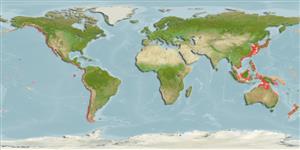Thysanocardia nigra (Ikeda, 1904)
| Native range | All suitable habitat | Point map | Year 2050 |

|
| This map was computer-generated and has not yet been reviewed. |
| Thysanocardia nigra AquaMaps Data sources: GBIF OBIS |
Upload your photos
Google image |
No photo available for this species.No drawings available for Golfingiidae.
Google image |
No photo available for this species.
Classification / Names Common names | Synonyms | CoL | ITIS | WoRMS
Sipunculidea | Golfingiiformes | Golfingiidae
Environment: milieu / climate zone / depth range / distribution range Ecology
Benthic; depth range 1 - 120 m (Ref. 1840). Subtropical
Distribution Countries | FAO areas | Ecosystems | Occurrences | Introductions
Pacific Ocean. Tropical to boreal.
Length at first maturity / Size / Weight / Age
Maturity: Lm ? range ? - ? cm Max length : 10.0 cm TRKL male/unsexed; (Ref. 1840); common length : 5.0 cm TRKL male/unsexed; (Ref. 1840)
Short description Morphology
Large animals, grayish-yellow, dark yellow, or gray in color. Trunk of adult specimens 2- 6 cm long, elongated and spindle-shaped. Introvert 1.5-2 times longer than trunk. Surface of trunk smoothseeming, as papillae covering it small. Papillae pyriform or finger-shaped. Tentacular apparatus obviously subdivided into dorsal crown surrounding nuchal organ and crown of perioral tentacles. Dorsal crown consisting of 19-30 tentacles. Tentacles of perioral crown
arranged into pronounced parallel festoons running along cephalon. In each festoon, pair of anterior tentacles closest to mouth opening with common basal fold encircling bases of tentacles. In large specimens, sometimes up to 20-30 festoons, each bearing two rows of
12-20 tentacles. Violet or yellow circles visible around apical ends of tentacles. Longitudinal
musculature of body wall solid, not divided into longitudinal bands. Two retractors of introvert, both ventral, fastened in posterior third of body, close to ventral nerve cord. Contractile vessel of complicated structure, covered with finger-shaped tubercles of orange or yellow color. Gut long, number of intestinal loops 18- 54. Two fixing muscles fastening upper regions of ascending and descending loops of intestine. Anal opening located level with nephridiopores. No rectal diverticulum found. Two nephridia, free, not fastened to body wall, length about 30 percent of body length.
Found on rocks, sand, silt and sea grass beds of the intertidal (Ref. 1783) and subtidal, shelf waters (Ref. 1840); coastal to shelf (Ref. 19). Subtidal, shelf waters (Ref. 1840); coastal to shelf (Ref. 19).
Life cycle and mating behavior Maturity | Reproduction | Spawning | Eggs | Fecundity | Larvae
Main reference
References | Coordinator | Collaborators
Maiorova, A.S. and A.V. Adrianov. 2005. (Ref. 1783)
IUCN Red List Status (Ref. 130435)
CITES status (Ref. 108899)
Not Evaluated
CMS (Ref. 116361)
Not Evaluated
Threat to humans
Human uses
| FishSource |
Tools
More information
Internet sources
BHL | BOLD Systems | CISTI | DiscoverLife | FAO(Publication : search) | Fishipedia | GenBank (genome, nucleotide) | GloBI | Gomexsi | Google Books | Google Scholar | Google | PubMed | Tree of Life | Wikipedia (Go, Search) | Zoological Record
Estimates based on models
Preferred temperature
(Ref. 115969): 7.1 - 20.6, mean 11.7 (based on 650 cells).
Price category
(Ref. 80766):
Unknown.


